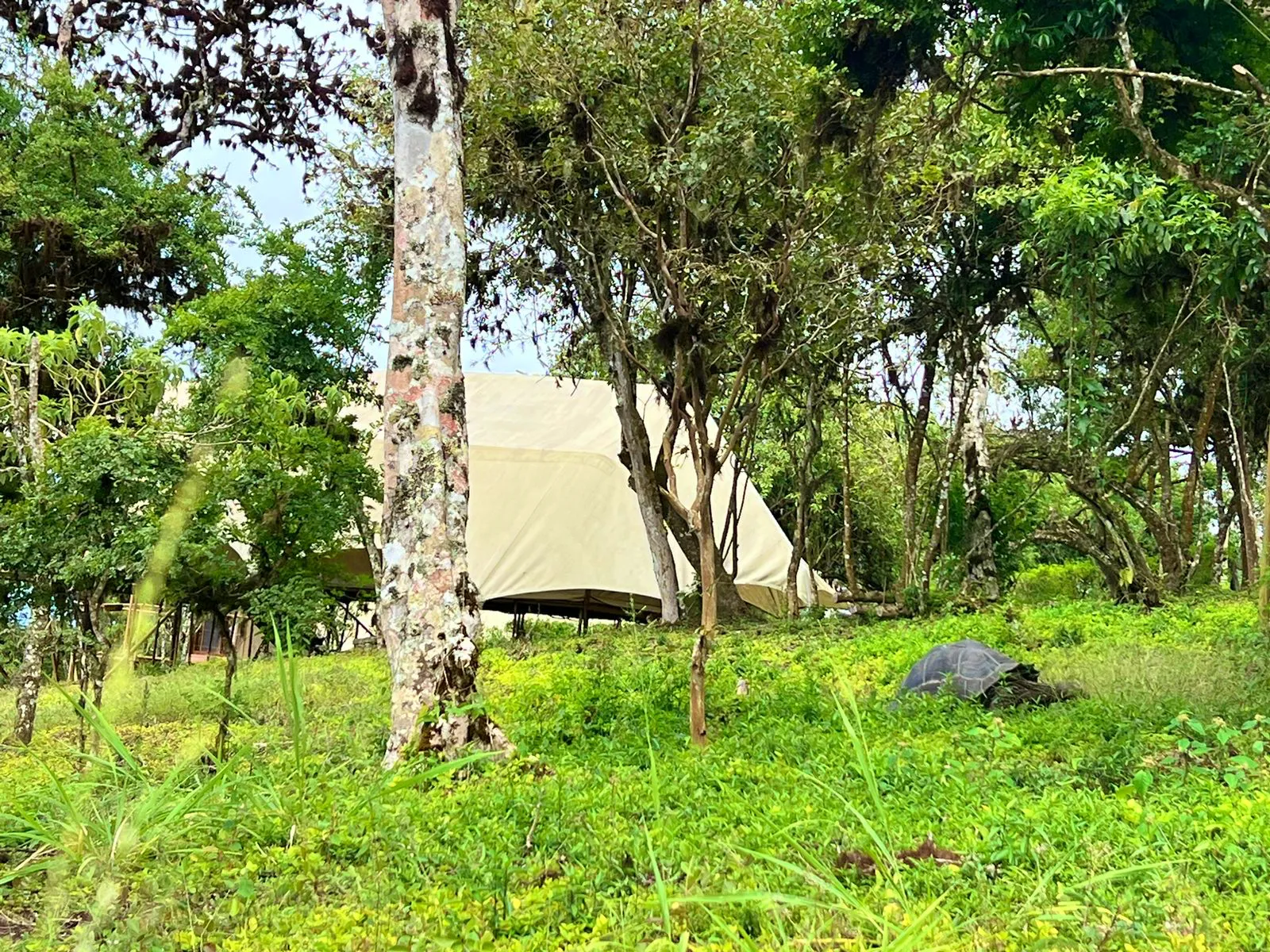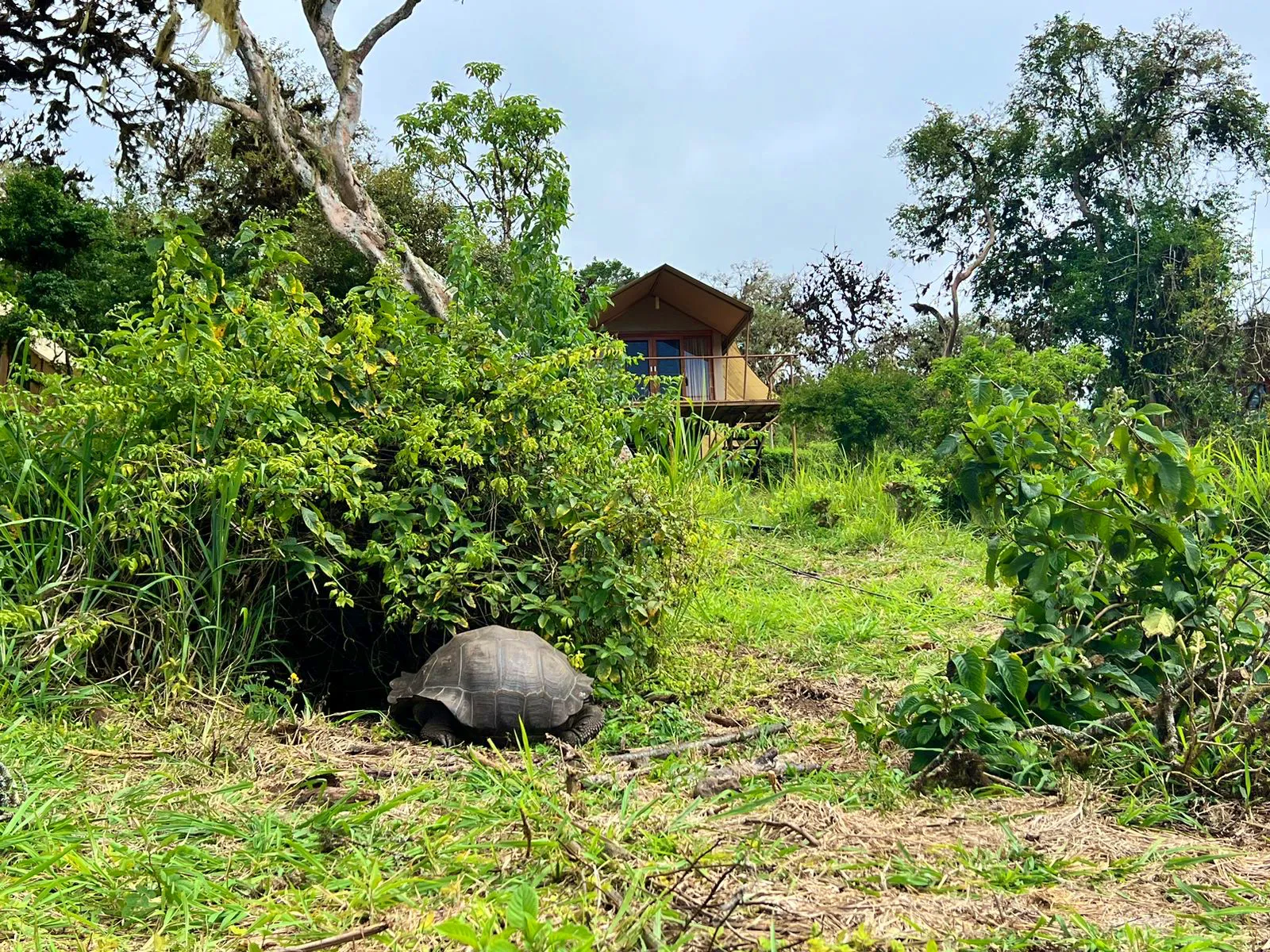Is September a good time to visit the Galapagos Islands?

Galapagos Safari Camp in September
September is a good time to visit for those who are less tolerant of the heat. Although it is never too cold, it can get a little chilly in the evenings and you might need a warm jumper or fleece.
Galapagos in September: Snapshot
Ocean currents: Humboldt Current’s influence continues.
Weather: Mildly cool and dry, with temperatures between 68°F to 82°F.
Seas: Cooler waters, with occasional choppier conditions.
Wildlife: Sea birds are active; abundant marine life.
Galapagos Weather in September

A tortoise passes through Galapagos Safari Camp (photo taken in September)
September falls within the Galapagos’ Cool and Dry Season. Air temperatures are cooler (around 67-80°F / 19-27°C), with reduced humidity, as are sea temperatures (68-74°F / 20-23°C). Underwater visibility is reduced too to approximately 5-20m. The misty phenomenon, known as ‘la garua’, occasionally cloaks the islands and consequently, there is less sunshine. There is also less rain.
The Ocean Currents in September
The marine environment of the Galápagos is largely determined by the interplay of its currents. In September, the following currents are of note:
The Humboldt Current is still dominant in September. This chilly, nutrient-rich current sweeps up the coast of South America, before circling westwards to the Galapagos Islands.
The Pacific Equatorial Undercurrent (or Cromwell Current) runs from west to east along the equator. When it reaches the Galapagos Islands, its cold waters are deflected to the surface, carrying nutrients from the ocean floor (a process called ‘upwelling’). These nutrients sustain the phytoplankton on the surface and the increase in plankton attracts an abundance of fish and seabirds.
The warmer Panama Current is less strong at this time of year, with the Humboldt Current remaining the dominant force for now.
Due to the nutrient rich waters, this is an excellent time to visit the islands if you are an avid diver or birdwatcher.
Choppy Seas in September
It’s worth noting that the open seas can get quite choppy during this time. If you suffer from sea sickness, it may not be the best time to take a cruise for example. At Galapagos Safari Camp, we can arrange short boat trips to neighbouring islands, as well as numerous tours and activities on Santa Cruz Island itself, including hiking, biking, kayaking, surfing, snorkeling, visits to tortoise reserves etc.
Galapagos Wildlife in September
September is a historically significant month for the Galapagos, marking the time when Charles Darwin first set foot on the islands in 1835 aboard the HMS Beagle. His observations of the unique and varied species on each island laid the foundation for his groundbreaking theory of evolution by natural selection. Today, the magic of September remains, with the islands vibrant and alive, showcasing an abundance of creatures in transition.
Giant tortoises

Giant tortoises are often at Galapagos Safari Camp in September
On Santa Cruz Island, the iconic giant tortoises embark on their slow-paced journey from the coast back to the verdant highlands. Their migration, a short trek of less than 4 miles (6km), can take 2 to 3 weeks, moving at a snail’s pace uphill. These tortoises, which once amused Darwin with their unhurried demeanor, are often seen ambling through Galapagos Safari Camp. Our land-based Safaris also include a visit to a private reserve for giant tortoises in the highlands of Santa Cruz.
Galapagos Penguins
The waters surrounding Bartolome Island present their own magic. Galapagos Penguins, having migrated from Isabela Island after the wet season, dominate the aquatic scene. They grace the waters around Pinnacle Rock, diving off cliffs and darting between snorkelers and playful sea lions in search of food. This September spectacle, easily accessible on our guided Safaris, promises unparalleled snorkeling experiences.
Sea Lions
North Seymour, Plazas, and Santa Fe Islands are abuzz with the sounds and sights of sea lions. Males aggressively guard their harems, ensuring safety for the newborn pups and their mothers. These young sea lion pups, curious by nature, are known to playfully engage with snorkelers. On land, these islands are a hub of avian activity. Sea birds, particularly blue-footed boobies and both the Great and Magnificent frigate birds, are in the midst of their parenting and mating rituals.
Our Safaris ensure an encompassing experience, taking you to some of these uninhabited islands and back to the comforts of the camp by sunset.
Galapagos Adventures in September
The cooler temperatures make hikes and biking adventures easier. Water activities like snorkeling promise a kaleidoscope of marine life, albeit in cooler waters.
Galapagos Safari Camp in September
In September, we usually close the camp for a couple of weeks to attend to any maintenance. The exact dates and length of closure varies each year, depending on the work required. Please contact us for further information.
Our fruit orchards

September marks the time when our mandarins are ripe and ready for picking.
A Quieter Month
September marks a waning of the number of people who visit the islands. Children are back in school after the summer break and it is a good time to visit if you are seeking peace and tranquility.
When to Visit the Galapagos by Month
For more information on the weather and wildlife in the Galapagos, please visit When to visit the Galapagos Islands or one of our monthly guides:
January, February, March, April, May. June, July, August, September, October, November, December.
Mainland Ecuador in September:
Amazon Rainforest:
Weather: Relatively drier periods interspersed with rain showers.
Attractions: Wildlife ventures closer to the riverbanks as water levels lower, ensuring better spotting opportunities.
See our Amazon Tours
The Andes (including Quito):
Weather: Pleasant days with cool evenings.
Attractions and Events: Cultural festivals in various highland towns offer a peek into local traditions.
See our Andes Tours
Cloud-Forest:
Weather: Rain showers alternate with clear skies.
Attractions: A burst of biodiversity awaits, from resplendent bird species to the evasive spectacled bear.
See our Cloud-Forest Tours
Wildlife Disclaimer
Our wildlife observations are based on our own personal experiences, combined with the insights of our guests and guides. However, nature is unpredictable, and we can’t guarantee sightings of specific species or behaviors.
